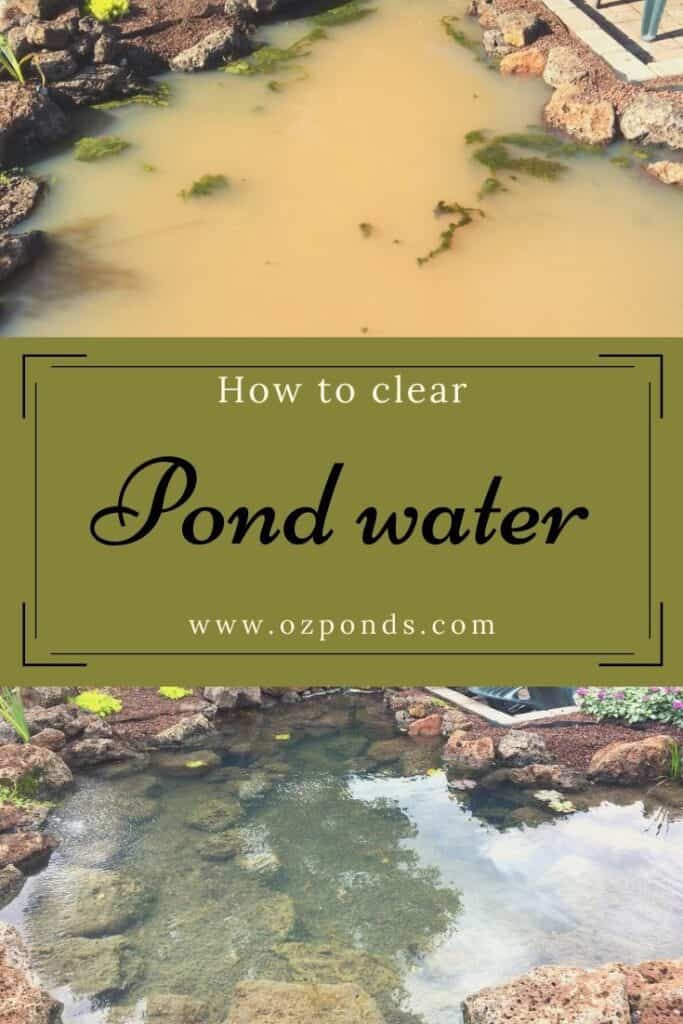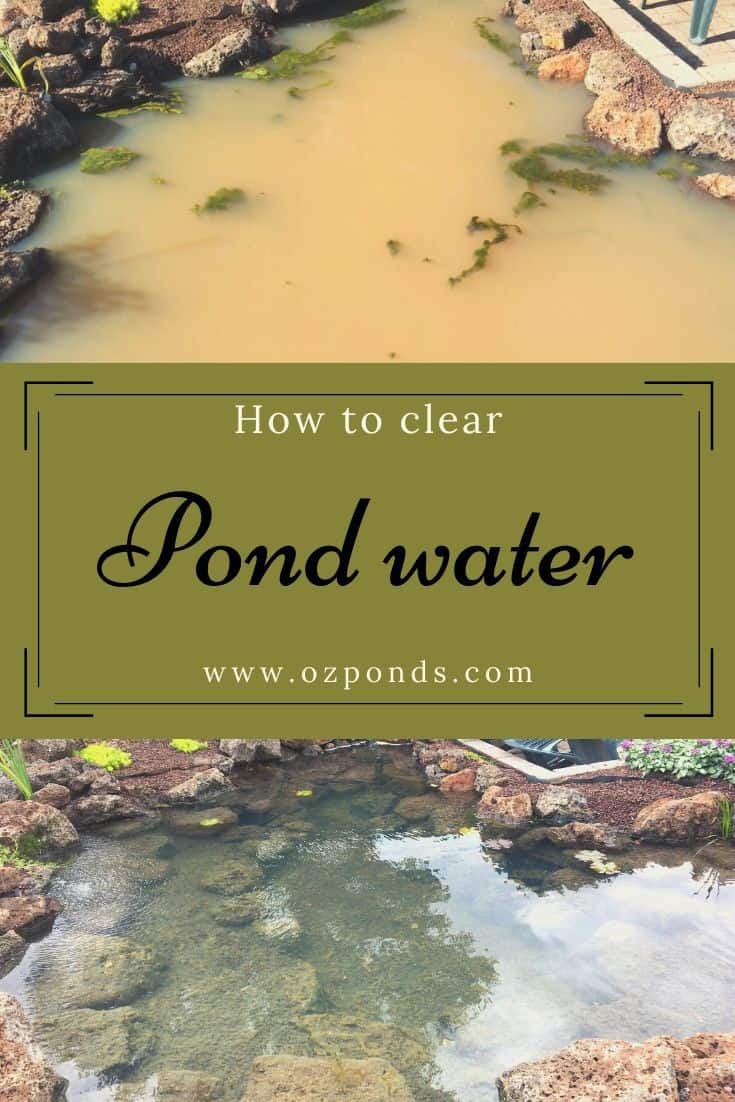There is a number of reasons that pond water appears cloudy, dirty or green. Don’t panic these are all common pond problems, with easy solutions.
There is no reason that everyone can’t enjoy crystal clear pond water!
Quite often when you build a brand new pond may be cloudy due to clay silt.
Another common issue with a new pond is an algae bloom. Both problems are easily fixed.
An established pond may have problems with green water or a build up of sludge and sediment that is clouding the water again easily fixed.
Keep reading to learn the solutions and get your pond back to looking 100%.
Cloudy water/ Dirty water
When i put in my front garden pond i used a lot of rocks. The rocks looked clean enough and i even rinsed them off with a hose. But when i started filling the pond it looked like a yellow mess!

This was due to all the little bits of clay suspended in the water. These bits of clay are so tiny that they will pass through the pumps and filters without settling.
The mineral components within the particles wont allow them to clump together, thus they remain suspended and keep the pond looking muddy and gross.
Not at all like the beautiful clear pond water i had envisioned.
This was the first pond i had ever built so i decided to drain the water using a sump pump purchased for $65 on eBay.
I then rinsed the rocks and gravel again. Pumped out this water and refilled the pond.
This worked a treat and i had the beautiful clear water i had dreamed of.
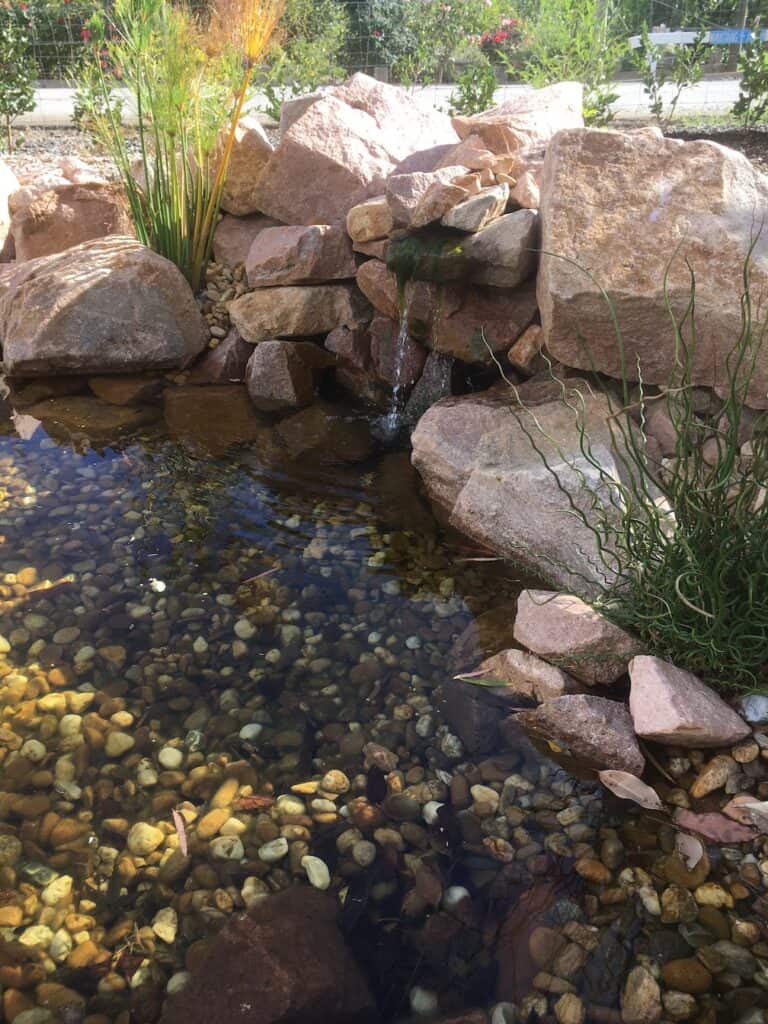
Since building that first pond i have learnt a great deal about ponds and keeping water clear and healthy.
A couple of weeks ago i built another pond. Again it was really muddy when i filled it up. This time i thought rather than emptying out the water i would try using a flocculent.
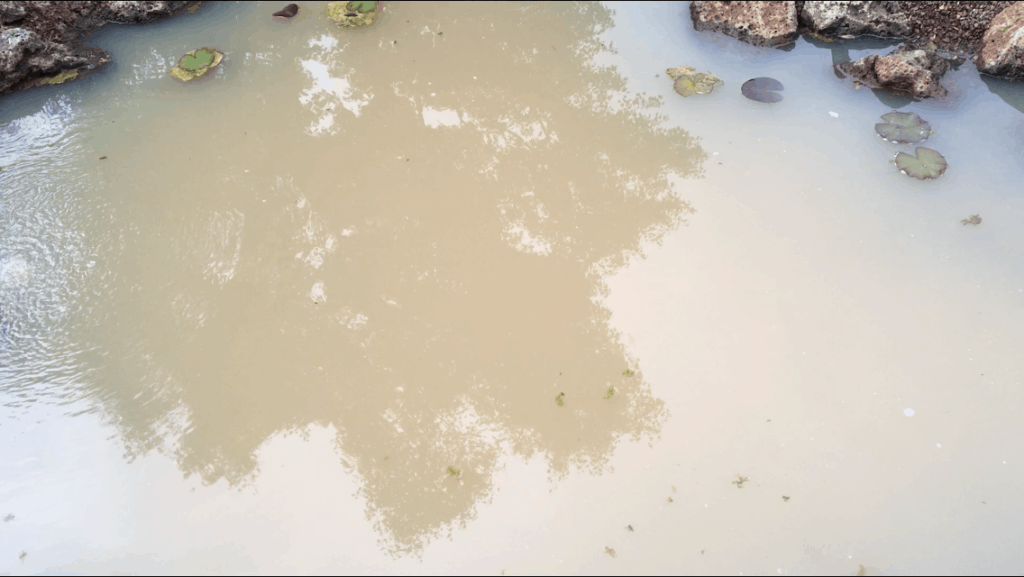
A flocculent works by binding suspended particles together, perfect for the suspended clay. Flocculent is incredibly fast acting, you’ll see results within a couple of hours!
Take a look at the video i made below showing what happened in the hours and days after adding it to my new pond.
Solution to fix cloudy/dirty pond water.
The quickest and easiest solution is using the flocculent. It’s very fast acting and works really, really well. It’s also safe for use in ponds with plants and fish already in.
If you prefer going chemical free, you’ll need to remove the muddy water and start again. Those suspended particles will never fully settle.
Prevention is often better than cure. If by some chance you a reading this before you actually build a pond rinse the rocks and gravel throughly before putting it into the pond.
Or build the pond and then rinse off the rocks and gravel before fully filling it up. This way you can save a lot of water. You will need a little sump pump.
You could use your existing pond pump. But you don’t want to really pump dirty water through it if you don’t have too. It can wear out the impeller shaft.

Algae bloom in a new pond
It wasn’t long after i got the muddy water out of my pond that the algae started growing. Arggg!
At first I was pulling it out manually but that was a waste of time and effort.
I soon learnt that algae in a new pond is perfectly normal and not something to be ashamed about, but something to celebrate.
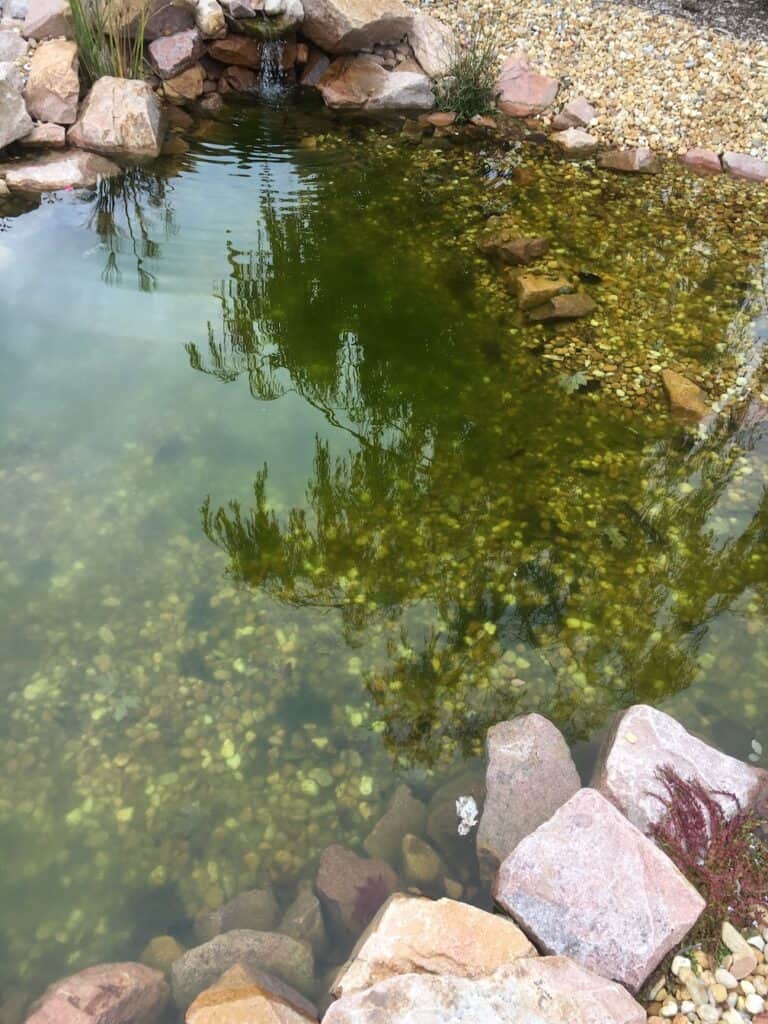
You see new need to establish a colony of good bacterias, which are essential to water health and crystal clear water. If you don’t know what I’m talking about check out this article I wrote- “A quick guide to the nitrogen cycle”.
So after some research i discovered that almost every new pond will go through a “green or algae” stage whilst the beneficial bacteria establish themselves.
The good news here was that no action on my part was required i simply sat back and allowed the pond and mother nature to find a balance.
Once this happened the algae growth disappeared. Although not entirely. It turns out that some algae in the pond is perfectly healthy.
Solution to algae bloom in a new pond
Patience or add some beneficial bacterias. Splosht is the brand i use in my ponds.
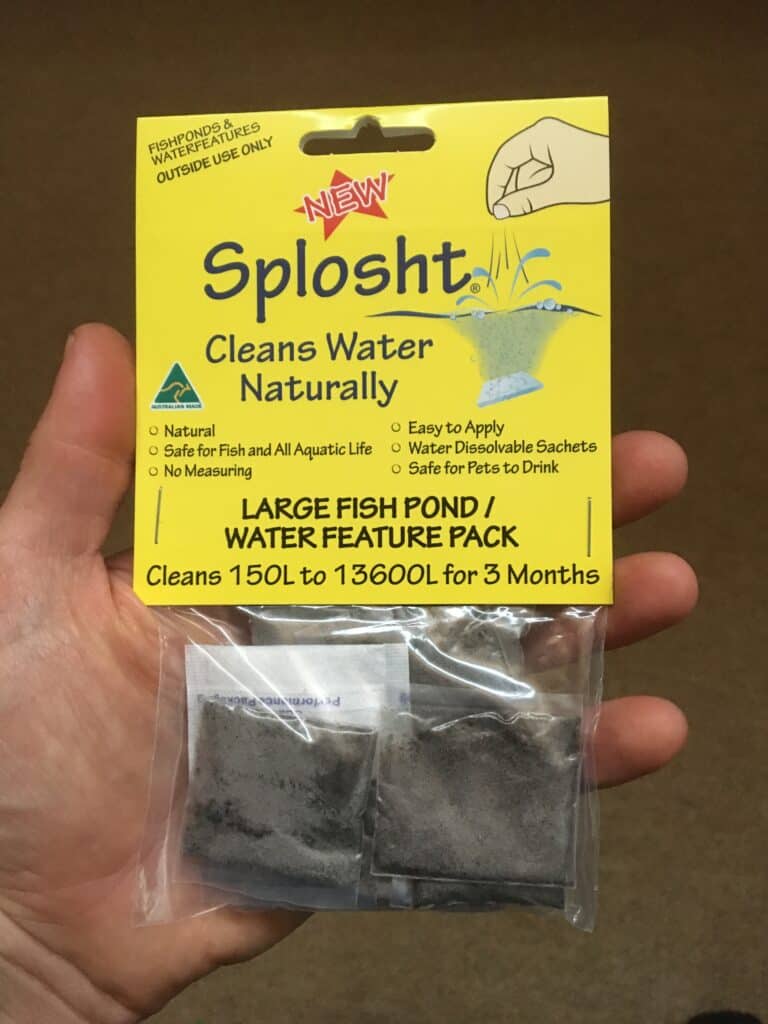
Algae problems for a new pond are easily fixed and no cause for worry.
Eventually your pond and mother nature will find a nice balance. The bacteria will colonise every nook and cranny within the pond and help keep the pond clean naturally.
Important information about topping up you pond
Never top your pond up with water direct from the mains water supply! Mains water contains chlorine and this is incredibly harmful for your pond bacteria.
If you accidentally kill off your bacteria you’ll be back at the beginning as if it was a brand new pond. If you need to add mains water to your pond use a chlorine neutraliser on the tap water.
You can also let the water sit for a few days to allow the chlorine to evaporate. Other options include using tank water or filtered water.
There are filters you can buy that remove chlorine from the water.
Green water in an established pond
It’s certainly not uncommon for a well established pond to turn green. There’s a simple explanation for this. There are too many nutrients within the water.
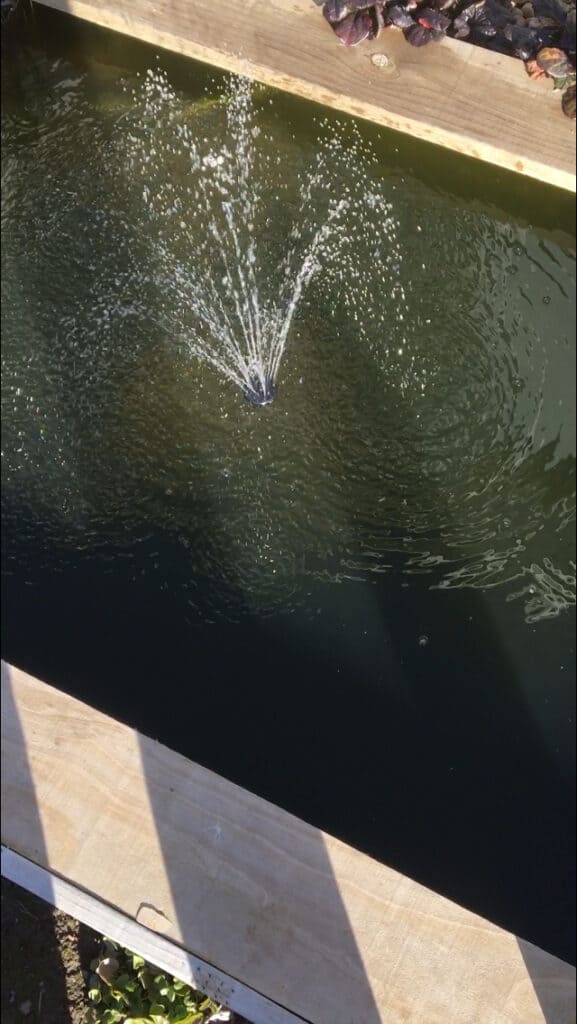
The green is caused by single celled algae. It’s a natural occurrence and it’s simply nature finding a balance. While it looks awful it’s in no way harmful to your fish and plants.
Goldfish actually love murky water, but excessive nutrients in the water can be a problem.
Generally you’ll find your pond turning green if it is overstocked with fish. Too many fish producing too much waste leading to too much nutrients.
Another cause is not enough biological filtration (those good bacterias).
I built a goldfish pond under my living room window and about 6 months after adding the fish the water turned pea soup green.
To fix the problem i added a bog filter to the pond. This incorporates biological filtration and plants to clean the water. I made a video that you can watch showing the results.
Solutions to fixing green pond water in an existing pond
- Add more plants. Aquatic plants will consume the excess nutrients this should rob the single celled algae of its food source, eventually starving it. This is a good long term solution.
- Add a wetland or bog filter to the pond. These are easily my favourite kinds of pond filters!! They are completely natural. In short they work by slowing water flow, providing more areas for beneficial bacteria and extra plants. Click here to learn more. Again another brilliant long term solution.
- For a quick fix. You can remove manually using your pump and a fine cloth or filter pads. This will usually take a few days and many rinses off the cloth or filter pads. Another option is additives such as flocculants and algaecides. Simply follow the instructions on the bottle. The last option is installing a UV filter. These use light to kill the algae as it moves through the filter. These last options work but they only really mask the problem. There is still too many nutrients in the water. By all means use them but make sure to also add more plants and consider adding a wetland/bog filter. Especially if you plan on keeping large numbers of fish in your pond.
- Reduce the number of fish in the pond.
Cloudy water in a well established pond
Water that appears cloudy is caused by sediment within the water. This will be all the debris that has fallen into the pond- Leaves, Fish poo, Dust etc. As these things break down they become smaller lighter. They will begin to float around within the water column.
There will always be some floating debris in a pond it’s when there’s heaps that you will notice it.
Solution to cloudy water in a well established pond
You’ll notice that many of the solutions to fixing cloudy water are the same as fixing green water with a few add-ons.
- Create a bog or wetland filter. I bang on about these all the time i know. But that’s cause they are just brilliant at solving so many pond problems. In the case of sediment they will trap the sediments. From time to time the sediment will need to be removed from the wetland/bog. I like to incorporate a valve that I can open to flush the sediment from the bog filter.
- Using skimmers or collection points. The more debris you can remove from the pond before it breaks down the less sediment will be in the water- Simple! Click here for more information on how skimmers and collection points work.
- Avoid having bare earth around your pond. Bare ground when it’s dry will generate dust. Dust is just fine dirt particles. This in your pond will float around forever! If the dust is from clay soils it can be really hard to remove as it never really settles to the bottom. Make sure to have plenty of plants around the pond. It looks better and should reduce the impacts of dust.
- Add more areas for beneficial bacteria. The bacteria is the engine room of the pond. It’s a case of the more the merrier. Adding a bog/wetland filter will add heaps of surface area for these little guys and girls to colonise. Other options are adding bio balls, ceramic noodles ect to where the water comes into the pond. This maybe as waterfall, stream or fountain. If the pond is bare liner or plastic consider adding pebbles and rocks.
- Adding activated carbon to the filter. Activated carbon will act as a sponge. The fine particles will become trapped thus clearing the cloudy water. An important thing to remember is that carbon needs regular replacement to be effective.
If you can incorporate the top 4 and maintain a sensible fish stocking level you should never have a problem with cloudy or green water!
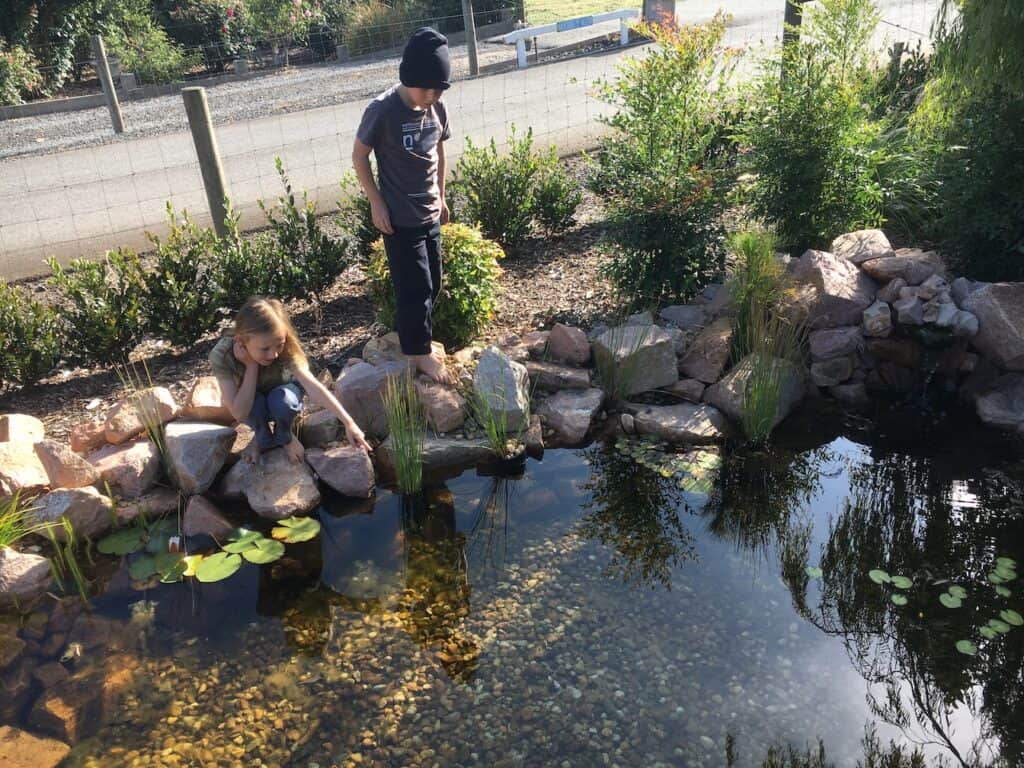
Solution to problems with leaf debris in a pond
Add a leaf net during autumn. This will capture most of the leaves and prevent the problem. This is fine for a small pond. Another option in a small pond is to net them out each day, it’s a pain in the bum but will prevent problems later.
For a larger pond you really should install a skimmer. These work by pulling water into them creating a current on the surface of the water. When the leaves fall in they get pulled by the current into the skimmer box. Then it’s simply a matter of removing the leaves from the skimmer basket.
This is still a viable option on a small pond. Just make sure it’s disguised so its not an eyesore.
You could also create a kind of DIY skimmer/collection point. To do this create a narrow channel and build it up with rocks to make the channel shallow.
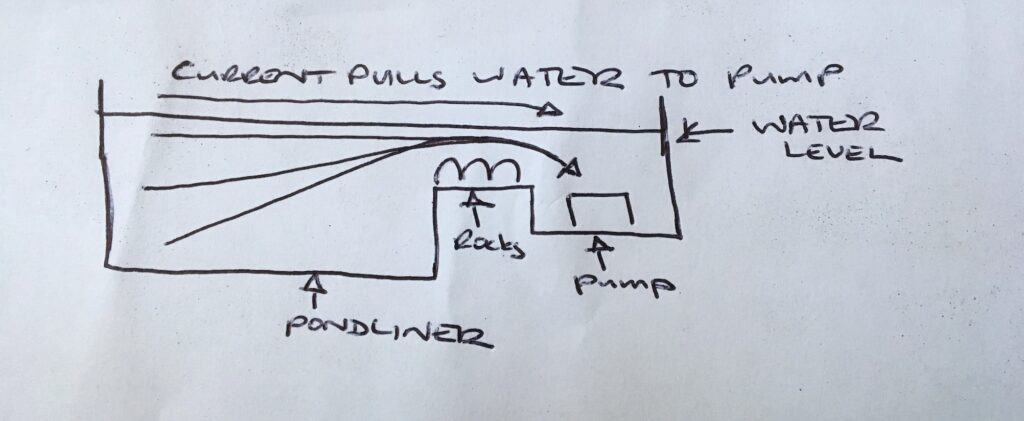
Place the pump on the other side of the channel. As the water is pulled through the narrow channel it will create a current. The leaves should be pulled into the area where the pump is and can then be easily removed.
Tea coloured pond water
Sometimes with leaf debris the water will become cloudy or tea coloured. This is caused by tannins.
Tannins are a natural by product of the break down of plant material in liquid. In this case our ponds.
The tannins are harmless to fish and i actually quite like the tea colour. However some don’t and there is a couple of easy solutions.
Solution to tea coloured pond water
You can use the skimmer/ collection points or leaf nets mentioned above to stop the leaves from settling in the pond in the first place.
A third option is incorporating activated carbon within your filtration system. The carbon acts like a sponge on very fine particles including tannins.
The only problem is carbon will require regular replacing. But it does work wonders in clearing the tannins.
Problems with runoff entering a pond
Runoff from the garden or lawn can contribute to high nutrients loads and in turn green water. As the water moves over the garden or lawn it will pick up pieces of dirt, mulch, lawn clippings these all contain nutrients that will be released into the water as they break down.
Solutions for runoff entering a pond
Stop the runoff from entering the pond. This can be achieved by bunching up the liner and hiding with rocks. The physical barrier will force the water around the pond instead of into it.
If you don’t have excess liner on the edges, create a small berm or shallow trench to channel water away from the pond. Again these physical barriers can be disguised with rock, plants and mulch.
Dead animals in a pond
This is not usually an issue but has been known to happen in large ponds. Occasionally a rabbit or possum my fall into the pond if it cannot escape it drowns.
Again it’s the decomposition that will release nutrients into the water. If it’s too much for the bacteria and pond plants to consume. Bam! you got green water.
Solution to stop animals drowning in a pond
The solution is easy, just make sure that animals that come down for a drink can escape the pond should they fall in. When designing a pond it’s important to have a beach area where the slope is gentle and animals can escape the water.
If you have an existing pond with steep banks incorporate some larger driftwood that can be used as a kinda bridge out of the water. Or some rocks to create a gentle slope or even some steps. It doesn’t matter as long as it looks good and will help the critters escape without clawing at your pond liner.
Hopefully this article has provided a solution or at least pointed you in the right direction, to being able to fix your particular problem.
Subscribe
Remember to subscribe to our mailing list to receive special offers on pond products and services.
